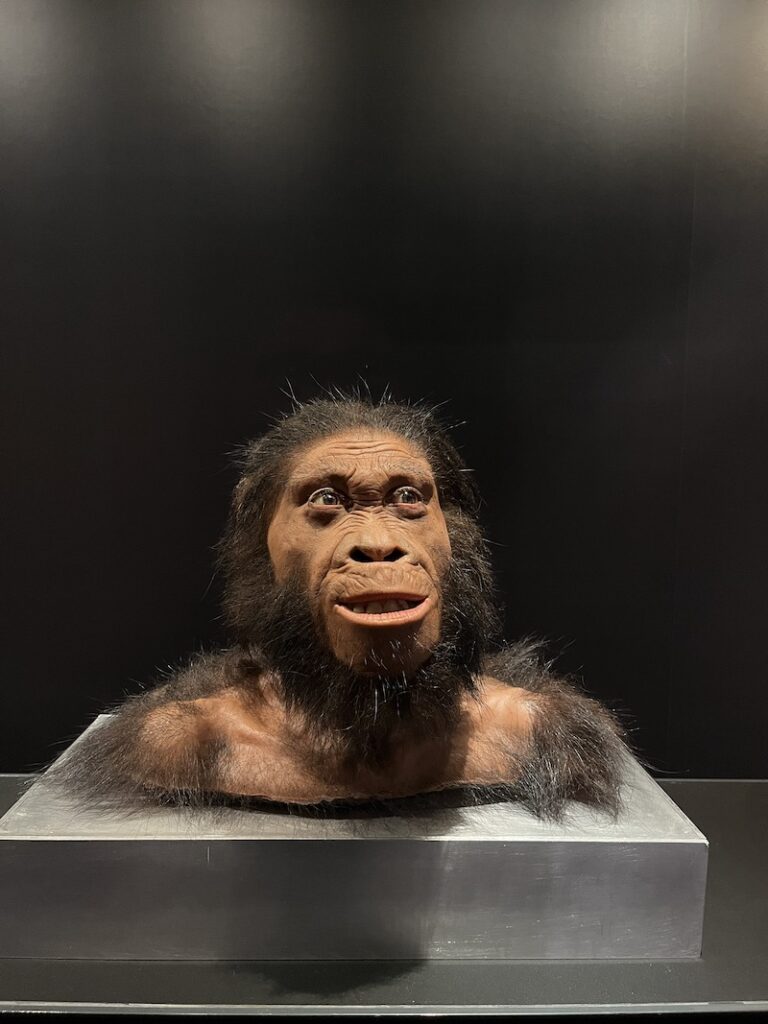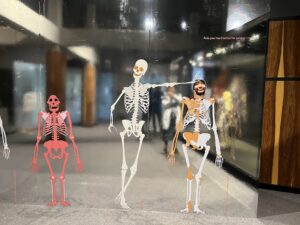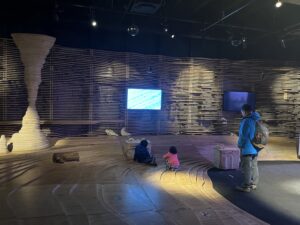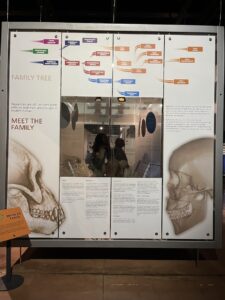On a cold and wet day, we made the trip to the Cradle of Humankind, about 50 km outside of Johannesburg. AY and I have been talking about this museum for months, so there was no way we were going to let the weather stop us. When we arrived, the place looked totally deserted without another car in the entire parking lot. Instead of risking not having a ride back, we asked our Uber driver to wait for us. To make it worth his while, we invited him to join us to visit the museum, to which he obliged.
The Cradle of Humankind is a paleoanthropological site that comprises 15 various sites, including a visitor’s center (museum), caves and other sites where fossils were unearthed. It is significant because it is where the densest concentration of fossils of our distant hominid ancestors, dating back to more than 3 million years ago, were unearthed. It was designated a UNESCO World Heritage Site in 1999.
The Sterkfontein Caves have been closed for several months due to flooding in the area, so our visit was limited to the visitor’s center. The museum was incredibly fascinating, with exhibits taking us through almost 4.6 billion years, beginning from when Earth came into existence as a ball of burning gas.
The focal point of the museum is our prehistoric lineage and the birth of modern humans, tracing back our ancient family tree to hominids that lived millions of years ago. The “Taung child” discovered in 1924 by Professor Raymond Dart of the University of the Witwatersrand was the first hominid fossil of its kind discovered in the area. Professor Dart gave the fossil remains the species name, Australopithecus africanus, which means “southern ape of Africa”. Australopithecus is an early ancestor of modern humans that lived 2-3 million years ago. Subsequently, many more fossil remains of Australopithecus, that are rare elsewhere in the world, were discovered nearby. Many of the fossils are on display in the museum.
It was fascinating to examine the skeletal remains and bone fragments of the ancient hominids and also to learn about the painstaking process of creating a likeness, or reconstruction, of an early hominid using incomplete bone fragments. The process is long and tedious and requires the participation of both scientists and artists, from discovery, unearthing, cleaning, assembling to reconstructing.
The museum was very thorough in describing not only the fossil remains and their significance, but the identities and personalities of the paleoanthropologists that dedicated their lives to the discovery of these fossils.
The part of the museum that interested me the most is understanding the evolutionary links of ancient hominids to modern day humans. Australopithecus is considered an early ancestor to homo sapiens and the link between them could be homo habilis, then homo ergaster. These are just educated guesses as even scientists are not sure of the exact path. We do know that homo sapiens are the only remaining hominids. There once were other species within our genus, but they are all extinct.
The museum makes a great effort to link the distant past to the present day and ultimately to our future. Our distant ancestors were able to survive and thrive in their immediate environment by activating their creativity and resourcefulness to work together and harness the surrounding natural resources. The resources on Earth are limited and our generation has reached a tipping point where the demands of the population exceed what nature is capable of providing. What choices will we make and what impact will our choices have on the future of our species?
Our future is mirrored in our past. The future of our species depends on the choices that we make today. We won’t know until much later whether the choices we make now are the right ones. Just as modern day humans seek to make sense of our existence by tracing back our history to our ancestral hominids, our future descendants will trace back their story to the choices that we as a species make today.
Author
-

Song is the mother of four children. She and her family have stepped away from it all and in September 2023, began traveling the world while homeschooling. Song is an ABC (American born Chinese) and has an undergraduate degree from Cornell and an MBA from Harvard. She is an entrepreneur and an educator. Her hobbies include learning, traveling, reading, cooking and baking, and being with children.











Another wonderful posting, as usual.
Look forward to reading about your experience in Egypt where your mom joined in. Understand she’s now back to Taipei.
You will be in Greece this month of December, where we toured a year ago. We also cruised to Kusadasi in Turkey, and Israel. Too bad you had to drop Israel from your list due to recent confrontations.